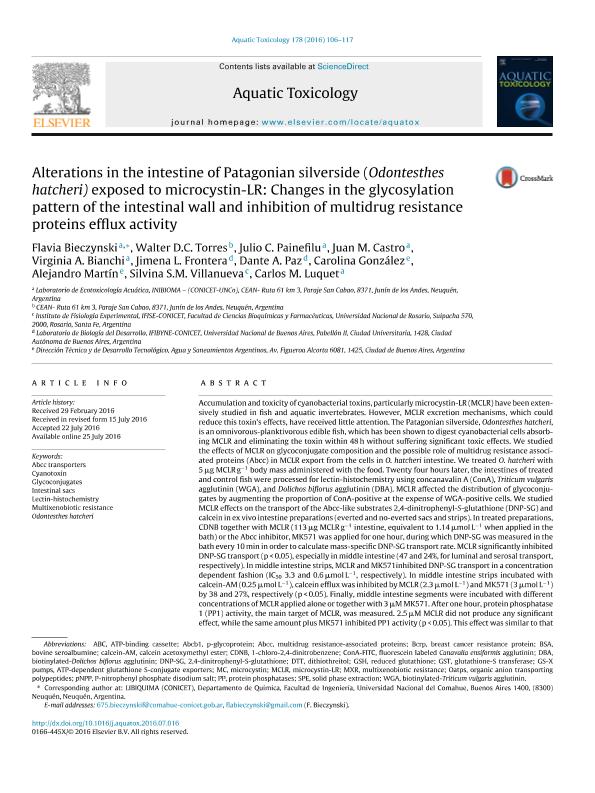Artículo
Alterations in the intestine of Patagonian silverside (Odontesthes hatcheri) exposed to microcystin-LR: Changes in the glycosylation pattern of the intestinal wall and inhibition of multidrug resistance proteins efflux activity
Bieczynski, Flavia ; Torres, Walter Ramon
; Torres, Walter Ramon ; Painefilú, Julio César
; Painefilú, Julio César ; Castro, Juan Manuel
; Castro, Juan Manuel ; Bianchi, Virginia Angélica
; Bianchi, Virginia Angélica ; Frontera, Jimena Laura
; Frontera, Jimena Laura ; Paz, Dante Agustin
; Paz, Dante Agustin ; González, Carolina; Martín, Alejandro; Villanueva, Silvina Stella Maris
; González, Carolina; Martín, Alejandro; Villanueva, Silvina Stella Maris ; Luquet, Carlos Marcelo
; Luquet, Carlos Marcelo
 ; Torres, Walter Ramon
; Torres, Walter Ramon ; Painefilú, Julio César
; Painefilú, Julio César ; Castro, Juan Manuel
; Castro, Juan Manuel ; Bianchi, Virginia Angélica
; Bianchi, Virginia Angélica ; Frontera, Jimena Laura
; Frontera, Jimena Laura ; Paz, Dante Agustin
; Paz, Dante Agustin ; González, Carolina; Martín, Alejandro; Villanueva, Silvina Stella Maris
; González, Carolina; Martín, Alejandro; Villanueva, Silvina Stella Maris ; Luquet, Carlos Marcelo
; Luquet, Carlos Marcelo
Fecha de publicación:
09/2016
Editorial:
Elsevier Science
Revista:
Aquatic Toxicology
ISSN:
0166-445X
Idioma:
Inglés
Tipo de recurso:
Artículo publicado
Clasificación temática:
Resumen
Accumulation and toxicity of cyanobacterial toxins, particularly microcystin-LR (MCLR) have been extensively studied in fish and aquatic invertebrates. However, MCLR excretion mechanisms, which could reduce this toxin's effects, have received little attention. The Patagonian silverside, Odontesthes hatcheri, is an omnivorous-planktivorous edible fish, which has been shown to digest cyanobacterial cells absorbing MCLR and eliminating the toxin within 48 h without suffering significant toxic effects. We studied the effects of MCLR on glycoconjugate composition and the possible role of multidrug resistance associated proteins (Abcc) in MCLR export from the cells in O. hatcheri intestine. We treated O. hatcheri with 5 μg MCLR g−1 body mass administered with the food. Twenty four hours later, the intestines of treated and control fish were processed for lectin-histochemistry using concanavalin A (ConA), Triticum vulgaris agglutinin (WGA), and Dolichos biflorus agglutinin (DBA). MCLR affected the distribution of glycoconjugates by augmenting the proportion of ConA-positive at the expense of WGA-positive cells. We studied MCLR effects on the transport of the Abcc-like substrates 2,4-dinitrophenyl-S-glutathione (DNP-SG) and calcein in ex vivo intestine preparations (everted and no-everted sacs and strips). In treated preparations, CDNB together with MCLR (113 μg MCLR g−1 intestine, equivalent to 1.14 μmol L−1 when applied in the bath) or the Abcc inhibitor, MK571 was applied for one hour, during which DNP-SG was measured in the bath every 10 min in order to calculate mass-specific DNP-SG transport rate. MCLR significantly inhibited DNP-SG transport (p < 0.05), especially in middle intestine (47 and 24%, for luminal and serosal transport, respectively). In middle intestine strips, MCLR and MK571inhibited DNP-SG transport in a concentration dependent fashion (IC50 3.3 and 0.6 μmol L−1, respectively). In middle intestine strips incubated with calcein-AM (0.25 μmol L−1), calcein efflux was inhibited by MCLR (2.3 μmol L−1) and MK571 (3 μmol L−1) by 38 and 27%, respectively (p < 0.05). Finally, middle intestine segments were incubated with different concentrations of MCLR applied alone or together with 3 μM MK571. After one hour, protein phosphatase 1 (PP1) activity, the main target of MCLR, was measured. 2.5 μM MCLR did not produce any significant effect, while the same amount plus MK571 inhibited PP1 activity (p < 0.05). This effect was similar to that of 5 μM MCLR. Our results suggest that in O. hatcheri enterocytes MCLR is conjugated with GSH via GST and then exported to the intestinal lumen through Abcc-like transporters. This mechanism would protect the cell from MCLR toxicity, limiting toxin transport into the blood, which is probably mediated by basolateral Abccs. From an ecotoxicological point of view, elimination of MCLR through this mechanism would reduce the amount of toxin available for trophic transference.
Archivos asociados
Licencia
Identificadores
Colecciones
Articulos(CCT - PATAGONIA NORTE)
Articulos de CTRO.CIENTIFICO TECNOL.CONICET - PATAGONIA NORTE
Articulos de CTRO.CIENTIFICO TECNOL.CONICET - PATAGONIA NORTE
Articulos(IFIBYNE)
Articulos de INST.DE FISIOL., BIOL.MOLECULAR Y NEUROCIENCIAS
Articulos de INST.DE FISIOL., BIOL.MOLECULAR Y NEUROCIENCIAS
Articulos(IFISE)
Articulos de INST.DE FISIOLOGIA EXPERIMENTAL (I)
Articulos de INST.DE FISIOLOGIA EXPERIMENTAL (I)
Articulos(INIBIOMA)
Articulos de INST. DE INVEST.EN BIODIVERSIDAD Y MEDIOAMBIENTE
Articulos de INST. DE INVEST.EN BIODIVERSIDAD Y MEDIOAMBIENTE
Citación
Bieczynski, Flavia; Torres, Walter Ramon; Painefilú, Julio César; Castro, Juan Manuel; Bianchi, Virginia Angélica; et al.; Alterations in the intestine of Patagonian silverside (Odontesthes hatcheri) exposed to microcystin-LR: Changes in the glycosylation pattern of the intestinal wall and inhibition of multidrug resistance proteins efflux activity; Elsevier Science; Aquatic Toxicology; 178; 9-2016; 106-117
Compartir
Altmétricas



